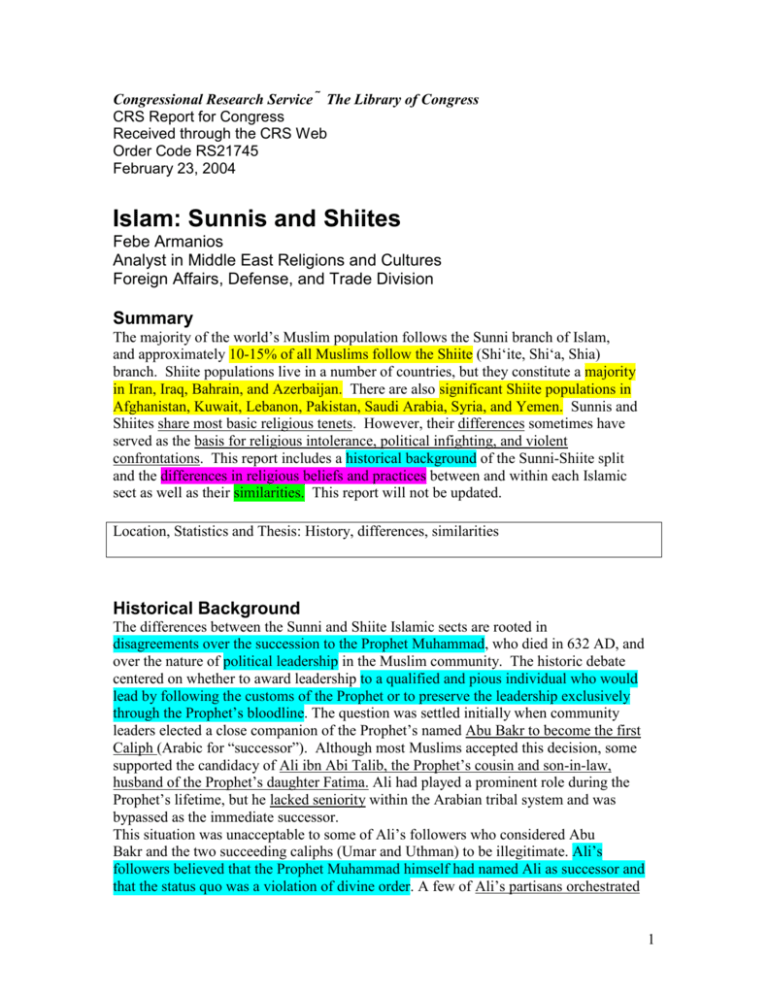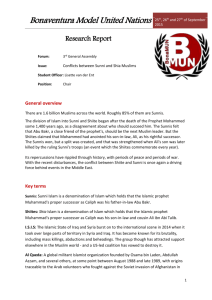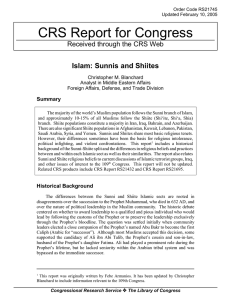Sunni and Shiite Differences Notes
advertisement

Congressional Research Service ̃ The Library of Congress CRS Report for Congress Received through the CRS Web Order Code RS21745 February 23, 2004 Islam: Sunnis and Shiites Febe Armanios Analyst in Middle East Religions and Cultures Foreign Affairs, Defense, and Trade Division Summary The majority of the world’s Muslim population follows the Sunni branch of Islam, and approximately 10-15% of all Muslims follow the Shiite (Shi‘ite, Shi‘a, Shia) branch. Shiite populations live in a number of countries, but they constitute a majority in Iran, Iraq, Bahrain, and Azerbaijan. There are also significant Shiite populations in Afghanistan, Kuwait, Lebanon, Pakistan, Saudi Arabia, Syria, and Yemen. Sunnis and Shiites share most basic religious tenets. However, their differences sometimes have served as the basis for religious intolerance, political infighting, and violent confrontations. This report includes a historical background of the Sunni-Shiite split and the differences in religious beliefs and practices between and within each Islamic sect as well as their similarities. This report will not be updated. Location, Statistics and Thesis: History, differences, similarities Historical Background The differences between the Sunni and Shiite Islamic sects are rooted in disagreements over the succession to the Prophet Muhammad, who died in 632 AD, and over the nature of political leadership in the Muslim community. The historic debate centered on whether to award leadership to a qualified and pious individual who would lead by following the customs of the Prophet or to preserve the leadership exclusively through the Prophet’s bloodline. The question was settled initially when community leaders elected a close companion of the Prophet’s named Abu Bakr to become the first Caliph (Arabic for “successor”). Although most Muslims accepted this decision, some supported the candidacy of Ali ibn Abi Talib, the Prophet’s cousin and son-in-law, husband of the Prophet’s daughter Fatima. Ali had played a prominent role during the Prophet’s lifetime, but he lacked seniority within the Arabian tribal system and was bypassed as the immediate successor. This situation was unacceptable to some of Ali’s followers who considered Abu Bakr and the two succeeding caliphs (Umar and Uthman) to be illegitimate. Ali’s followers believed that the Prophet Muhammad himself had named Ali as successor and that the status quo was a violation of divine order. A few of Ali’s partisans orchestrated 1 the murder of the third Caliph Uthman in 656 AD, and Ali was named Caliph. Ali, in turn, was assassinated in 661 AD, and his sons Hassan (ca. 670 AD) and Hussein (680 AD) died in battle against forces of the Sunni caliph. Those who supported Ali’s ascendancy became later known as “Shi‘a,” a word stemming from the term “shi‘at Ali,” meaning “supporters” or “helpers of Ali.” There were others who respected and accepted the legitimacy of his caliphate but opposed political succession based on bloodline to the Prophet. This group, who constituted the majority of Muslims, came to be known in time as “Sunni,” meaning “followers of [the Prophet’s] customs [sunna].” In theory, Sunnis believe that the leader (imam) of the Muslim community should be selected on the basis of communal consensus, on the existing political order, and on a leader’s individual merits. This premise has been inconsistently practiced within the Sunni Muslim community throughout Islamic history. The caliphate declined as religious and political institution after the thirteenth century, although the term “caliph” continued to be used by some Muslim leaders until it was abolished in 1924 by Turkey’s first President Mustafa Kemal Ataturk. Succession Dispute; Sunnis want qualified leader and Shiites want leader from bloodline; Abu Bakr and Ali situation; Shiite's ascent caliph through assassination; Ali is assassinated as well. Meaning of Shiite. Sunni leader qualifications. Shiite Islam: Development and Basic Tenets Initially, the Shiite movement gained a wide following in areas that now include Iraq, Iran, Yemen, and parts of Central and South Asia. In most of the world, Shiites would continue as a minority. Today, according to some estimates, Shiite Islam is practiced among approximately 10% to 15% of the world’s Muslim population. Leadership of the Community. For Shiites, the first true leader of the Muslim community is Ali, who is considered an imam, a term used among Shiites not only to indicate leadership abilities but also to signify blood relations to the Prophet Muhammad. As Ali’s descendants took over leadership of the Shiite community, the functions of an imam became more clearly defined. Each imam chose a successor and, according to Shiite beliefs, he passed down a type of spiritual knowledge to the next leader. Imams served as both spiritual and political leaders. But as Shiites increasingly lost their political battles with Sunni Muslim rulers, imams focused on developing a spirituality that would serve as the core of Shiite religious practices and beliefs. Shiites believe that when the line of imams descended from Ali ended, religious leaders, known as mujtahids, gained the right to interpret religious, mystical, and legal knowledge to the broader community. The most learned among these teachers are known as ayatollahs (lit. the “sign of God”). Shiite Jurisprudence and Core Beliefs. The basic sources for Islamic jurisprudence, be it Sunni or Shiite, are the Quran, the sunna (customs of the Prophet Muhammad) as relayed in the hadiths (sayings of the Prophet and his companions), qiyas (analogy), ijma‘ (consensus), and ijtihad (individual reasoning). The primary function of the learned religious leaders is the interpretation of Islamic law (shari‘a). There are no 2 codified laws in either Sunni or Shiite Islam. Rather, there are sources for the interpretation of law, and these sources are similar among Shiites and Sunnis. Shiite hadiths differ from Sunni hadiths, mainly in that they include the sayings of the Shiite imams who are considered to have been divinely inspired. Shiite legal interpretation, in contrast to Sunni interpretation, also allows more space for human reasoning. Shiite religious practice centers around the remembrance of Ali’s younger son, Hussein, who was martyred near the town of Karbala in Iraq by Sunni forces in 680. His death is commemorated each year on the tenth day of the Islamic month of Muharram in a somber and sometimes violent ritualistic remembrance known as “Ashura,” marked visited on February 20, 2004. among some Shiites by the ritual of self-flagellation. As a minority that was often persecuted by Sunnis, Shiites found solace in the Ashura ritual, the telling of the martyrdom of Hussein and the moral lessons to be learned from it, which reinforced Shiite religious traditions and practices. Ismaili or Sevener Shiism. Although most Shiites agree on the basic premise that Ali was the first rightful imam, they disagree on his successors. The Ismailis, who are the second largest Shiite sect, broke off in the eighth century, recognizing only the first seven imams (the seventh was named Ismail, hence the names “Ismaili” and “Sevener”). Historically and at least until the sixteenth century, the Ismailis were far more disposed than the Twelvers to pursuing military and territorial power. In the past, they established powerful ruling states, which played significant roles in the development of Islamic history. Today, Ismailis are scattered throughout the world but are prominent in Afghanistan (under the Naderi clan), in India, and in Pakistan. There are also Ismaili communities in East and South Africa. Sunni Islam: Development and Basic Tenets Religious Practices and Beliefs. The majority of Muslims today are Sunnis. They accept the first four Caliphs (including Ali) as the “rightly guided” rulers who followed the Prophet. They reject the belief that the subsequent Shiite imams are divinely inspired leaders who should be revered. Sunni Muslims do not bestow upon human beings the exalted status given only to prophets in the Quran, in contrast to the Shiite veneration of imams. Sunnis have a less elaborate and arguably less powerful religious hierarchy than Shiites. In contrast to Shiites, Sunni religious teachers historically have been under state control. At the same time, Sunni Islam tends to be more flexible in allowing lay persons to serve as prayer leaders and preachers. In their day-to-day practices, Sunnis and Shiites exhibit subtle differences in the performance of their obligatory prayers. Both groups share a similar understanding of basic Islamic beliefs. Sectarian Divisions. Sunni Islam has had less prominent sectarian divisions than Shiite Islam. The Ibadi sect, which is centered mostly in Oman, East Africa, and in parts of Algeria, Libya, and Tunisia, has been sometimes misrepresented as a Sunni sect. While, in general, the Ibadi religious and political dogma resembles basic Sunni doctrine, the Ibadis are neither Sunni nor Shiite. The Ibadis believe strongly in the existence of a 3 righteous and just Muslim society. They argue that the Muslim leader should be chosen for his knowledge and piety, without regard to race or lineage, and that he should be selected by the leaders of the community. The Sunni puritanical movement called “Wahhabism” has become well-known in recent years and is arguably the most pervasive revivalist movement in the Islamic world. This movement, founded in Arabia by the scholar Muhammad ibn Abd al-Wahhab (1703-1791 AD), is considered to be an offshoot of the Hanbali school of law. Unlike other schools of law, which usually relied on scholarly interpretations of religious texts, Hanbali followers tended to apply the Quran and the hadith in a literal way. In the same vein, Abd al-Wahhab encouraged a return to the pure and orthodox practice of the “fundamentals” of Islam, as embodied in the Quran and in the life of the Prophet Muhammad. In the eighteenth century, Muhammad ibn Saud, founder of the modern-day Saudi dynasty, formed an alliance with Abd al-Wahhab as he began the process of unifying disparate tribes in the Arabian Peninsula. From that point forward, there has been a close relationship between the Saudi ruling family and the Wahhabi religious establishment. The most conservative interpretations of Wahhabi Islam view Shiites and other non-Wahhabi Muslims as dissident heretics. Shared Beliefs and Practice Core Beliefs. Although there are considerable differences between Sunni and Shiite Islam, the two Islamic sects share common traditions, beliefs, and doctrines. All Muslims believe that the Prophet Muhammad was the messenger of Allah (the Arabic word for God). All believe that they must abide by the revelations given to the Prophet by Allah (as recorded in the Quran) and by the hadith. The concepts of piety, striving for goodness, and social justice are fundamental to Islamic belief and practice. Additionally, all Muslims are expected to live in accordance to the five pillars of their faith: (1) shahada - recital of the creed “There is no God but Allah, and Muhammad is His Prophet”; (2) salat - five obligatory prayers in a day; (3) zakat - giving alms to the poor; (4) sawm - fasting from sunrise to sunset during the month of Ramadan; and (5) hajj making a pilgrimage to Mecca once during a lifetime if one is physically and financially able. 4









